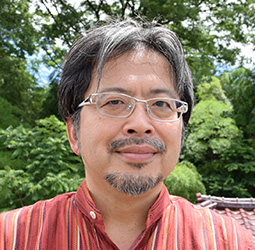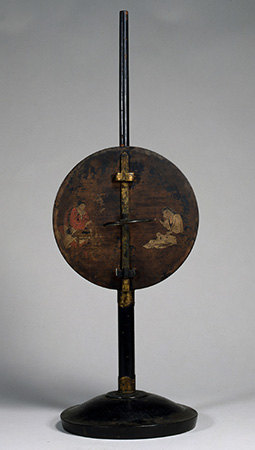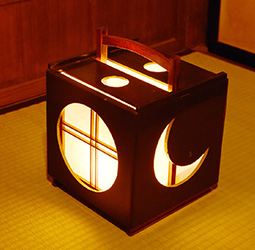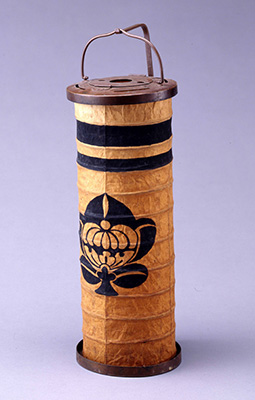July 2022
- English
- 日本語
The Lighting of Japan

A reproduction gas light (foreground) in the Minatomirai area of Yokohama City, Kanagawa Prefecture 
An illuminated float at the Aomori Nebuta Festival

Fujiwara Takumi 
Todai (light stand) (78 cm) with reflective panel dating from the thirteenth or fourteenth century, a treasure of Horyu-ji Buddhist temple in Nara Prefecture (Tokyo National Museum Collection) 
An Ariake-andon lantern (300 x 230 x 232 mm) (Collection of Musashino Art University Museum & Library) 
An Odawara-chochin (Odawara Lantern) (42.5 cm) (Edo-Tokyo Museum Collection)

Fujiwara Takumi is a lighting designer and researcher of lighting culture, and President of Light Meister Co., Ltd. We asked him about the history and culture of lighting in Japan.

What are the origins of lighting in Japan?
Until the incandescent light bulb and other modern light fixtures were popularized in the nineteenth century, lighting was created by burning something with fire both in Japan as well as in most countries and regions in the world. Lighting was first created with trees and plants, followed by oil, and then finally with candles.
In Japan, it is thought that oil was used as a fuel for lighting by at least the Asuka period (end of the sixth century to the beginning of the eighth century). The light fixture that began to be used around that time was the todai (light stand). A wick made from the pith of the stem of a plant called igusa (common rush) was dipped in a dish filled with oil made from squeezing plants and boiling fish. The wick, which had soaked up the oil, was then lit with fire to create a light. The taka-todai (tall light stand) had a 75- to 90-cm-tall pillar supporting a dish, and was used as a light for rooms.
As the light from oil-based light stands could be easily extinguished when the wind blew, people of the time came up with ways to block the wind. For example, a round reflective panel is attached to a light stand thought to be made in the thirteenth or fourteenth century and protected as a treasure of Horyu-ji, a Buddhist temple in Nara Prefecture. This reflective panel not only protects against the wind, but also reflects the light.
Light stands with pillars of 30 to 45 cm in height were also made. Before Western culture spread in the Meiji period (1868–1912), the average Japanese person did not use chairs while inside, and sat on wooden or tatami (matting made of common rush) floors to work or eat. But tall light stands could not brightly light up the area in front of people when sitting on the floor, and so light stands with low pillars came to be used as light fixtures to brighten the area in front of a person while sitting down. Later, a diverse variety of light fixtures was created to match the climate, lifestyles and cultures of Japan.
What other kinds of light fixtures were created in Japan?
The Edo period, which began at the start of the seventeenth century, was a period in which no major wars broke out for about 260 years and is said to be an era when the lighting culture of Japan flourished. Various new light fixtures became prevalent and people’s lives came to be colored with these lights. One of these was the andon. Like light stands, andon used oil as fuel, but they were unique in that the oil dish was surrounded by a hibukuro (fire box to block the wind). Washi handmade paper, which had also become popularized during the Edo period, was attached to the fire box. The entire fire box was then illuminated as the light from inside the andon reflected on the washi paper. This is why andon seem to be brighter than light stands. The warm, gentle light that radiates from the washi paper gives people a sense of security.
There are many varieties of andon, one of which is the Ariake-andon. The name is said to come from the fact that the moon seen even at daybreak (ariake) is known as an Ariake moon. The Ariake-andon was a hibukuro inside another wooden box which had cut-outs in the sides in the shape of full and crescent moons. In waking hours, the hibukuro could be removed and placed on top of the box to brightly illuminate the room. When a person went to bed, the hibukuro would be placed back inside the box and light would escape only from the moon-shaped cut-outs. The user could adjust the light emanating from the lantern in this way. It’s possible to get a sense for the strong preferences Japanese people have towards lighting from these ideas.

Japanese candles, which use lacquer trees and wax trees for fuel, were also popularized in the Edo period, and people began making light fixtures for these candles. One of those is the chochin lantern. These lanterns feature washi paper fixed onto a frame of thin bamboo strips, with a lit candle inside. The lantern could be folded up, so it was easy to carry. Thanks to the chochin lanterns, people of the Edo period were able to do more at night than in the past, this being a time when there were almost no street lamps.
It is said that the Odawara-chochin (Odawara Lantern), one of the most famous types of lanterns, was developed by an artisan living in Odawara (now Odawara City, Kanagawa Prefecture) as a portable lantern for travelers, as Odawara was a post-station town on the Tokaido road that connected Edo (now Tokyo) with Kyoto. Odawara-chochin are made so that when the “lids” at the top and bottom are pushed together, the hibukuro folds in (like an accordion) and can be easily stored and carried. During the Edo period, traveling became quite popular among ordinary people, and chochin were essential items for this travel.

Chochin lanterns are still used today in a variety of locations in Japan, including festival venues and outside izakaya bars. You could say that the chochin symbolizes the lighting culture of Japan, even as the times change.
How did the lighting of Japan change as modernization progressed since the Meiji period?
Japanese lighting saw a time of great transformation during the Meiji period as a variety of tools and technologies were brought in from the West. The first gas light was installed in Yokohama in 1872. The gas light came to be a symbol of Japanese modernization as up until that point, there were very few permanent street lamps in Japan. In 1882, the first arc lamp in Japan using electrical discharge lit up Ginza, a busy neighborhood in Tokyo. Kerosene lamps also became popular in homes, as they were brighter and easier to use than andon and chochin.
As lighting in Japan was changing in this way, American Thomas Edison completed the world’s first practical incandescent light bulb in 1879. Then, he commercialized it by using bamboo from Kyoto as a filament material that conducts electricity and lights up. This light bulb spread around the world, and lights were switched to these bulbs globally. With electricity being offered to general consumers in Tokyo in 1887, incandescent light bulbs began to be used as street lamps and electric lights in homes.
As electric lights were spreading, Japanese people developed a variety of technologies and contributed greatly to the development of electric lights. Some of these technologies were globally unique inventions. For example, the double coil light bulb, invented in 1921. By taking the spiral filament and further spinning it into a spiral—or double coil—the light bulb became brighter. Subsequently, in 1925, the frosted light bulb was invented. By frosting the inside of the glass of the light bulb, it became possible to control the glare of the bulbs to create soft and gentle light.
In recent years, Japanese researchers and companies have greatly contributed to the development of technologies, including light-emitting diodes (LEDs)* with long life and high efficiency and organic EL**, which makes it possible to have thin, lightweight, curved displays. Professor Akasaki Isamu at Meijo University, Professor Amano Hiroshi at Nagoya University, and Professor Nakamura Shuji at the University of California, Santa Barbara were awarded the 2014 Nobel Prize in Physics for their achievements in the development of a high-efficiency blue LED***.

Once the spread of COVID-19 subsides, what kinds of Japanese lighting do you want visitors from overseas to see in Japan?
People can enjoy a variety of lights at traditional festivals all over Japan. For example, at the Nebuta Festival**** held in Aomori Prefecture in summer, giant, brightly illuminated nebuta floats representing warriors or other mythical and historical figures are carried and paraded around town. The Kiriko Festival***** held across the Noto Peninsula in Ishikawa Prefecture from summer to autumn is decorated with tall, hanging rectangular lanterns that are illuminated, known as kiriko.

There are also many places to enjoy beautiful night views in Japan. One characteristic of Japanese night view spots is that many of them are not just from tall buildings but from the tops of mountains, as well. I recommend the night views seen from the tops of mountains in Hakodate and Nagasaki.
I also want visitors to look at Japan’s natural light. Moonlight has been cherished in Japan since ancient times. The cherry blossoms in full bloom, dimly lit by the moonlight in spring, are beautiful. This is called hanaakari (flower light). In winter, there are kamakura (snow huts)****** in snowy landscapes. The light from within the huts together with the moonlight create a beautiful sight of lightly glowing white snow. This is called yukiakari (snow light).
In traditional homes and temples in Japan, the light flowing in through sliding paper doors and the shadows that fall change from one moment to the next from daybreak to nightfall. Indoor paintings on folding screens or on sliding paper doors offer unique impressions depending on how the light hits them. I hope visitors to Japan can experience these kinds of changes that occur with natural light.
* Light-emitting diodes (LEDs) are a type of semiconductor that emit light when an electrical current is applied. They are used in a variety of products, including indoor and outdoor lighting, TVs, smartphones, and automobile lights.
** Organic EL is a phenomenon whereby organic materials emit light when voltage is applied. Devices that make use of this phenomenon are called OLED (Organic Light Emitting Diodes).
*** Until the 1980s, red and green LEDs were put into use and were used in indicator lights and other machines. Later, LEDs came to be widely used as lighting with the development of blue LEDs in 1993 and white LEDs in 1996.
**** See Highlighting Japan September 2011, “A Rousing Summer in Tohoku” https://www.gov-online.go.jp/eng/publicity/book/hlj/html/201109/201109_03.html
***** See Highlighting Japan August 2016, “The Noto Lights” https://www.gov-online.go.jp/eng/publicity/book/hlj/html/201608/201608_13_en.html
****** See Highlighting Japan January 2022, “Yokote Snow Festival” https://www.gov-online.go.jp/eng/publicity/book/hlj/html/202201/202201_03_en.html

